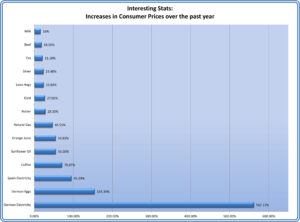Two Market Indicators at Odds: Equity Risk Premium and Credit Spreads
Equity Risk Premium:
The equity risk premium (ERP) is widely defined as the excess return that investing in the stock market provides over a risk-free rate (think Treasury bills, bonds and notes). This excess return compensates investors for taking on the additionally higher risk of investing in equities. The size of the premium varies and is dependent on the level of risk in a portfolio. As market risk fluctuates, it will change over time.
As we know, stocks are considered high-risk investments, but they also have the potential for more rewards. So, it makes sense that investors would be compensated with higher premiums when investing in the stock market. The expected return one can earn above a risk-free investment, such as Treasuries listed above, is called an equity risk premium.
The equity risk premium is based on the “risk-reward trade off”. There is no real way to know how much an investor will profit in the future. So, one method is an estimation using backward looking figures. An observation of the stock market and government bond markets over a defined period of time is used as inputs to calculate historical performance numbers that are then used to estimate future equity market performance. As an example, in 2024, the S&P 500 with dividends returned 26.1%. A Baa rated corporate bond returned 8.7% and a 3-month Treasury bill (T-bill) returned 5.1%. The estimated ERP would be 26.1 – 8.7% = 17.4%. From 2014 to 2023, the average return of the S&P 500 with dividends was 11.91%, a Baa corporate bond was 4.32%, and a 3-month Treasury bill was 1.27%. Using these numbers the expected equity risk premium would be 11.91% – 4.32% = 7.59% – both of these calculations indicate good expected future market returns. However, a second method of calculation estimates the ERP using forward – looking inputs. This method uses growth in earnings where the expected return is equal to the earnings yield (the reciprocal of the price-to-earnings ratio or P/E ratio). The P/E ratio of the stock market today by one measure is about 22 times earnings (the widely used CAPE ratio is about 37 times earnings). So, if the risk-free rate based on the current 3-month T-Bill is 4.31%, the equity risk premium would be about 0.24(4.55% (the reciprocal of the 22X P/E ratio) – 4.31%). The higher the equity risk premium, the more you will potentially earn from investing in the stock market. However, if the numbers that are widely used in the marketplace for the year 2025 and beyond are even remotely accurate, the future equity market returns will be much lower than in the past few years.
Credit Spreads:
A credit spread or yield spread (known as both), is the difference in yield between two debt securities (bonds) of the same maturity but having different credit qualities (think Treasuries versus Junk bonds, for example). Investors keep a keen eye on credit spreads as they are considered one of the best indicators of the broader economy’s health and investor sentiment, not just the health of one individual company.
Credit spreads are measured in basis points. One basis point equals 0.01% or 1.00% equals 100 basis points. Other terms used are bond yields and default spreads. One can quickly compare the yields of corporate bonds of difference creditworthiness to risk-free alternatives.
For example, if a 10-year Treasury note yields 5.00% and a 10-year corporate bond yields 8.00%, the credit spread between the two bonds is 3.00% or 300 basis points. Analysts use the spreads to assess the broader economic climate by aggregating all corporate bonds of a particular type and then subtract the Treasury rates. Wider yields can potentially mean an unhealthy outlook while narrowing yields indicate economic optimism.
In Conclusion:
Current credit spreads are very narrow signaling all is well in the economy. The ERP, on the other hand, is razor thin or even negative based on the reciprocal P/E ratio one uses – signaling potentially low equity returns for the foreseeable future.
Market Commentary:
2024 was another year of volatility and speculation. The stock indexes were up due to the “magnificent 7” again – (Alphabet, Apple, Amazon, Meta, Microsoft, Tesla, Nvidia)– the stocks that got hit hard in 2022 but were back to even in 2023. Approximately 53.7% of the performance of the S&P in 2024 was due to these 7 stocks. The other 493 stocks in the index were either flat or negative. The valuation of the S&P 500 is at or near all-time highs. Money market rates declined a little in 2024 due to the curious lowering of interest rates by 0.50% (only three other times in history and at extremely troubled economic times- not the case now) by the Federal Reserve. One can draw their own conclusions from this policy decision. As we stated in our last newsletter the long-term stock market average has been about 8-9%. With government money market mutual funds paying a little under 5%, investors can get more than half the long-term average performance with no risk. There is still much uncertainty and risk here and around the world. The new administration has noble goals but achieving them will not be easy. Having some cash reserves now affords us to earn a decent rate of return while waiting for better market conditions and to put more money to work. Having reserves provides opportunity. Opportunity to invest when we have a clearer picture of the future policy changes and good value presents itself. As always, we are ever optimistic that these opportunities will do just that.

We appreciate and thank you for the trust and confidence you have placed in Occam Capital® Management, LLC.

